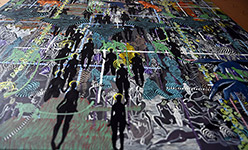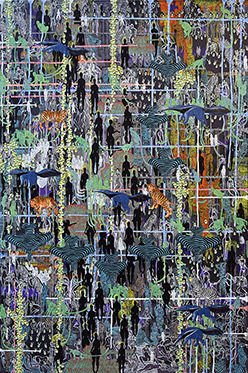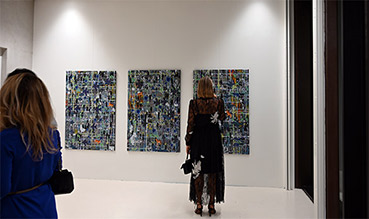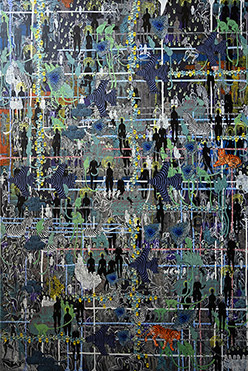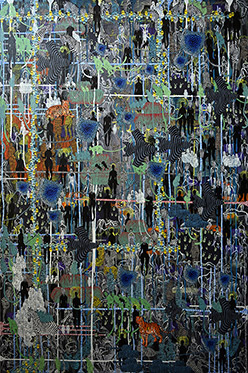
The World Beyond -7 by OtGO 2021-2022,
acryl on canvas, 150 x 100 cm
Triptych The World Beyond
-- The original text in French --
-- The text in German --
-- The text in Lithuanian --
-- The text in Nederlands --
Translated by Caroline Girod, edited by Elisa Kohl-Garrity. The English translation made public on 20 September 2022 Berlin
Someone
once asked a guide on Mount Everest if an old climber had a chance of
reaching the summit. He replied as follows: Maybe. But in the end, it
is the mountain that decides1.
This
quote perfectly illustrates the primordial role that nature plays in
our lives. She serves us as much as a spiritual master as she fulfils
her role as nurturer. Never resentful, she continues to keep humanity
alive despite the perpetual assaults of mankind. Human beings depend on
her generosity; like two sides of the same coin, they are bound to her.
However, instead of acting with her in symbiosis, they loot and destroy
her, forgetting that the death of nature will lead them to their own
extinction. Every day, like kamikazes, we wage a suicide war against
our own self, against our own ally. And it is on this most burning
theme that the artist Otgo ponders over with his work Triptych The
World Beyond (2021-2022).
As usual, OtGO has created three very rich canvases. Very detailed, his works invite the spectators to get as close as possible to them, even if it means touching them with the tip of the nose. The details of faces, expressions and movements become perceptible, and so the paintings reveal all the treasures they contain. As we plunge our eyes into the artist's paintings, the story begins. Wild animals and fishes invade the canvases: different species of monkeys, tigers, zebras, anteaters, rays. The canvases are teeming with life. However, beyond the exotic and colorful animals, some masks appear; they are everywhere and only bulging eyes have been depicted on the surface of the masks. The absence of mouths, noses, but especially of emotions gives them a chilling aspect. As for the human beings, who are sort of lifeless black silhouettes, they are wandering, condemned, in silence. Others are transformed into silhouettes of different colors or transparent. While the first resemble disarticulated dolls, the second figures seem to be disappearing from the world little by little and until they become barely perceptible. Just like the masks, these silhouettes no longer have faces. For the first as for the latter, the disappearance of a body or the breaking of a soul lead to silence and death.
1. John-Kabat Zinn, Où tu vas tu es, Éd. J’ai lu 1995
